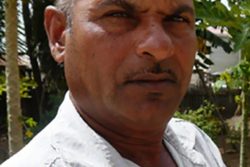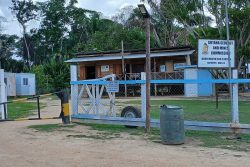Six years ago, within weeks of my return to live in Guyana, I was in conversation with a very well-known Guyanese – someone I admired but had never met – and he suddenly said to me, “Dave, what are you doing coming back to live in this godforsaken country?” I pointed out to him that he was also still here, and we both laughed over the remark. Coming forward to this time, given the litany of traumas that seem to have accumulated on us recently, my friend’s remark, seeming extreme at the time, strikes me as not laughable at all now. Time and again, I am seeing some egregious condition in the society that leads me to ask, “How did we get it so wrong?”
Just last week, doing business in Georgetown, I was appalled to see the state of our once-proud City Hall; from any angle one approaches it, our City Hall looks like a candidate for the dump. The building is simply decrepit. Indeed, with a visiting friend in the car, who was keen to see the city, I drove past the structure and deliberately didn’t point it out as our City Hall. I was truly ashamed. I was silently thinking, “How did that building get that way? We are not short of craftsmen and technicians; how is it that we are unable to execute the fundamental maintenance of keeping our public buildings in order? One can probably excuse neglect of a cargo warehouse on some lonely street, but the most important building in our town? What is the matter with us?”
Relating to my friend’s comment from six years back, how indeed have we become so “godforsaken”? How is it, for example, that we cannot keep our city from flooding? It is not rocket science; Georgetown has a system of gutters, canals and kokers laid out to move water to the river; all we have to do is keep it clear.
That was done in the time of the Dutch and the British as a matter of course. Why is that fundamental task us beyond us? Why are we getting it so wrong?
 Last week, attempting to cross the Demerara Harbour Bridge I found myself in what I can only describe as a maelstrom of cars, trucks, and minbuses in a monstrous vehicular log jam. The bridge had to be closed suddenly for some emergency, but no one thought to have a police officer or security guard organize the traffic so it accumulated like fish caught in a net.
Last week, attempting to cross the Demerara Harbour Bridge I found myself in what I can only describe as a maelstrom of cars, trucks, and minbuses in a monstrous vehicular log jam. The bridge had to be closed suddenly for some emergency, but no one thought to have a police officer or security guard organize the traffic so it accumulated like fish caught in a net.
We sat sweltering in this clog, for some 20 minutes, and then when the bridge reopened, there was another melee as the tangle of vehicles tried to slowly merge a collection of clusters into more or less manageable lines.
In the Guyana in which I grew up, two police officers would have been on the spot as the closure began lining up the traffic for the opening. Why have we moved away from those common sense approaches, and why don’t we recognize the problem and fix it?
Why are we apparently condoning the shocking state of our markets? Stabroek Market, a place I patrolled regularly as a Vreed-en-Hoop traveller, is not only a disgrace but even a rotting hazard on the riverside.
As we have seen this week, Bourda is a structure that leaks from above and floods from below. The market building in Kitty is virtually abandoned, seemingly about to collapse under its own weight. Even Mon Repos, to the east, is in disrepair with many vendors resorting to makeshift stalls on the roadside with the inevitable traffic congestion.
Customers still brave the conditions in search of fresh produce, but compared to places such as St Lucia, Barbados, St Vincent and Trinidad, our markets are a shocking indictment on our ability to manage, and the condition has been so for years. Why does it continue? When will it end? Recently I passed close to Philip Moore’s sculpture of Cuffy in Revolution Square and was struck by how casually we are treating what is generally considered to be the premier piece of large-scale outdoor sculpture ever produced in the Caribbean. Philip’s majestic work, which catches the eye from any direction, hundreds of yards away, should be framed by a low fence, and all the various paraphernalia accumulating around it should be removed.
Revolution Square should indeed become a shrine for Philip’s masterpiece. More than two years after his passing, why are we not presenting his work with dignity and respect?
On a different subject, in the process of writing this column, we see that Castellani House is currently hosting an exhibition of the work of Guyana’s premier artist, Stanley Greaves, on the occasion of his 80th birthday. Why, I am compelled to ask, are we not simultaneously bestowing on Stanley an appropriate national award, such as the Order of Roraima (he already holds the AA) or perhaps the Cacique Crown of Honour? This is an artist who has been a pioneering creator, tutor and educator, here and abroad, who has produced a powerful collection of award-winning work spanning several disciplines, including sculpture, ceramics and drawings.
He has achieved an international reputation as a painter, and his work is found in collections all over the world. Stanley is one of a kind; he is a credit to Guyana. What is clouding our vision that we have him here, in an 80th celebration, and we don’t take the opportunity for exceptional national honours for the gentleman? Why were Philip Moore and Aubrey Williams, to name just two, not similarly honoured before their passing?
Why the lapse?
Most Guyanese would of course read the list above and have examples of their own in the same vein. Guyana, and Georgetown in particular, abounds with these woeful examples of neglect and failure and abandonment. Known to all, they stare us in the face every day leaving us to ponder the fundamental: with some 50 years experience in running our own affairs, why do we continue to get so many things so badly wrong?








